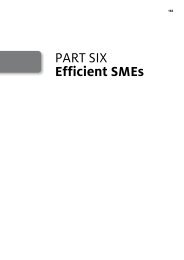The growing business handbook : inspiration and advice ... - Sparkler
The growing business handbook : inspiration and advice ... - Sparkler
The growing business handbook : inspiration and advice ... - Sparkler
Create successful ePaper yourself
Turn your PDF publications into a flip-book with our unique Google optimized e-Paper software.
Cash flow management<br />
143<br />
3 Keep a close eye on stock levels<br />
A <strong>business</strong> needs enough stock to fill orders in a timely manner, but adequate<br />
sales are needed to minimize stock levels. Stock includes finished products held<br />
for future sales as well as raw materials held for future production. Both types<br />
of stock represent cash that has been spent but that has not yet generated a<br />
return. It is fundamental that stock levels are monitored in line with the<br />
<strong>business</strong>’s sales pipeline of orders.<br />
4 Underst<strong>and</strong>ing working capital<br />
<strong>The</strong> time it takes to buy a product, sell it <strong>and</strong> collect the debt can vary<br />
significantly from <strong>business</strong> to <strong>business</strong>. <strong>The</strong> company will be invoiced for the<br />
stocks bought as soon as they are received so at that point the cash flow time<br />
lag is ticking. <strong>The</strong> time-lag issue must be quickly addressed by collecting<br />
payments <strong>and</strong> sending invoices in a timely manner. You do not have to invoice<br />
just once a month – it can be done weekly or on the day the sale is made.<br />
5 Supplier payment reviews<br />
It is often quite easy to delay payment of supplier invoices to help improve<br />
cash flow constraints. However, there is often a fine line between delayed<br />
payments <strong>and</strong> late payments. Crossing that line <strong>and</strong> incurring additional costs<br />
for late payments is normally not a good cash flow management technique – it<br />
can also agitate important suppliers <strong>and</strong> potentially lead to a loss of a key<br />
supplier. Do not hesitate to take advantage of credit offered by suppliers <strong>and</strong><br />
always negotiate for better terms rather than just accepting the st<strong>and</strong>ard terms.<br />
6 Monitoring customer payments history<br />
Monitoring key customers may provide insight into their payment profile.<br />
Some customers will pay in line with credit terms <strong>and</strong> it is simple to include<br />
them in the cash cycle. However, it is monitoring those customers who often<br />
pay late that is vital. A <strong>business</strong> should consider implementing new payment<br />
procedures for customers who continually pay late. It is pretty simple these<br />
days to download credit rating reports on new customers – this type of<br />
procedure should be utilized in order to assess customers when they are taken<br />
on or when you become concerned about their payment profile. Payment<br />
terms influence potential customers, but be cautious not to offer over-generous<br />
payment terms.<br />
7 Cash flow forecasts<br />
A projected cash flow forecast should be developed. Forecasts will help<br />
identify when there is a lack of cash expected in the <strong>business</strong> <strong>and</strong> hence will<br />
help allow time to try to alleviate this issue. Keeping the bank informed of<br />
your projections will help them underst<strong>and</strong> the <strong>business</strong> better.<br />
8 Maintaining up-to-date management information<br />
Continual cash flow management is only as good as the information on which<br />
it is implemented. A record-keeping system that provides information useful to<br />
making decisions regarding cash inflows <strong>and</strong> outflows is essential.








